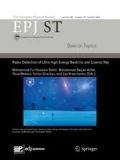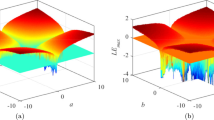Abstract
We first review ideas of harnessing chaotic attractors to implement robust and flexible logic gates, and recast these concepts in the context of tipping points. The central idea is as follows: The presence of tipping points in complex systems endows it with the capability to switch between very different attractors under small changes in parameter, and this feature can be exploited to obtain reliable logic operations. The binary logic outputs can be efficiently mapped to dynamical attractors bounded in different phase space regions, and the logic inputs can be simply encoded through small changes in a parameter. We then go on to extend our central idea with new implementations of multiple-input logic operations. We show explicitly that the system jumps consistently in response to an external stream of multiple inputs, thus offering robust realizations of more complex multi-input logic gates. We demonstrate that the existence of tipping points offers the advantage that very low-amplitude inputs can yield highly amplified outputs. We also show that noise may play a constructive role, enhancing the reliability of the emergent multi-input logic operations, thus strengthening the concept of generalized Logical Stochastic Resonance. These results indicate that the tipping mechanism can serve to construct general purpose computing devices, which have the added capacity to reconfigure logic functionalities efficiently by small parameter changes.







Similar content being viewed by others
References
L. Dai, D. Vorselen, K.S. Korolev, J. Gore, Generic indicators for loss of resilience before a tipping point leading to population collapse. Science 336(6085), 1175–1177 (2012)
D.C. Nepstad, C.M. Stickler, B. Soares-Filho, F. Merry, Interactions among amazon land use, forests and climate: prospects for a near-term forest tipping point. Phil. Trans. of Royal Soc. B 363 (2008)
K.P. Singh, R. Kapri, S. Sinha, Scalable ultra-sensitive detection of heterogeneity via coupled bistable dynamics. Europhys. Lett. 98, 60004 (2012)
V. Kohar, A. Choudhary, K.P. Singh, S. Sinha, Verification of scalable ultra-sensitive detection of heterogeneity in an electronic circuit. Eur. Phys. J. Special Topics 222, 721–728 (2013)
K. Murali, S. Sinha, V. Kohar, B. Kia, W.L Ditto. Chaotic attractor hopping yields logic operations. PLoS One 13(12), e0209037 (2018)
M. Lakshmanan, K. Murali. Chaos in nonlinear oscillators: controlling and synchronization, vol. 13. World scientific (1996)
M. Lakshmanan, S. Rajasekar. Nonlinear dynamics: integrability, chaos and patterns. Springer, Berlin (2012)
S. Sinha, W.L. Ditto, Dynamics based computation. Phys. Rev. Lett. 81(10), 2156 (1998)
S. Sinha, W.L. Ditto, Computing with distributed chaos. Phys. Rev. E 60(1), 363 (1999)
B.S. Prusha, J.F. Lindner, Nonlinearity and computation: implementing logic as a nonlinear dynamical system. Phys. Lett. A 263(1), 105–111 (1999)
H. Peng, Y. Yang, L. Li, H. Luo, Harnessing piecewise-linear systems to construct dynamic logic architecture. Chaos 18, 033101 (2008)
I. Campos-Canton, J.A. Pecina-Sanchez, E. Campos-Canton, H.C. Rosu, A simple circuit with dynamic logic architecture of basic logic gates. Int. J. Bifur. Chaos 20(8), 2547–2551 (2010)
M.Morris. Mano, Computer system architecture 3rd. Ch, 13:13–2, (1993)
T.C. Bartee, Computer architecture and logic design (1991)
K. Murali, S. Sinha, W.L. Ditto, Implementation of nor gate by a chaotic chua’s circuit. Int. J. Bifurcation Chaos 13(09), 2669–2672 (2003)
K.E. Chlouverakis, M.J. Adams, Optoelectronic realisation of nor logic gate using chaotic two-section lasers. Electron. Lett. 41(6), 359–360 (2005)
K. Murali, S. Sinha, W.L. Ditto, Realization of the fundamental nor gate using a chaotic circuit. Phys. Rev. E 68(1), 016205 (2003)
R. Jaimes-Reátegui et al., Optoelectronic flexible logic gate based on a fiber laser. Eur. Phys. J. Spec. Top. 223, 2837–2846 (2014)
S. Sinha, T.Munakata, W.L Ditto. Parallel computing with extended dynamical systems. Phys. Rev. E 65(3), 036214 (2002)
D. Cafagna, G. Grassi, Chaos-based computation via chua’s circuit: Parallel computing with application to the sr flip-flop. In Signals, Circuits and Systems, 2005. ISSCS 2005. International Symposium on, vol. 2, pp. 749–752. IEEE (2005)
M. Sathish Aravindh, A. Venkatesan, M. Lakshmanan. Strange nonchaotic attractors for computation. Phys. Rev. E 97, 052212 (2018)
P.R. Venkatesh, A. Venkatesan, M. Lakshmanan, Design and implementation of dynamic logic gates and rs flip-flop using quasiperiodically driven murali-lakshmanan-chua circuit. Chaos Interdiscip. J. Nonlinear Sci. 27(3), 033105 (2017)
P.R. Venkatesh, A. Venkatesan, M. Lakshmanan, Implementation of dynamic dual input multiple output logic gate via resonance in globally coupled duffing oscillators. Chaos Interdiscip. J. Nonlinear Sci. 27(8), 083106 (2017)
M.S. Hasan, M.B. Majumder, A.S. Shanta, M. Uddin, G.S. Rose. Evaluation, optimization, and enhancement of chaos based reconfigurable logic design. In 2019 SoutheastCon, pp. 1–6 (2019)
A. S. Shanta, M.B. Majumder, M.S. Hasan, G.S. Rose, Physically unclonable and reconfigurable computing system (purcs) for hardware security applications. IEEE Trans. Comput. Aid. Des. Integr. Circ. Syst., pp. 1 (2020)
P.L. Gentili, M.S. Giubila, B.M. Heron, Processing binary and fuzzy logic by chaotic time series generated by a hydrodynamic photochemical oscillator. ChemPhysChem (2017)
R. Storni, H. Ando, K. Aihara, K. Murali, S. Sinha, Manipulating potential wells in logical stochastic resonance to obtain xor logic. Phys. Lett. A, 376(8), 930–937 (2012)
K. Murali, S. Sinha, W.L. Ditto, A.R. Bulsara, Reliable logic circuit elements that exploit nonlinearity in the presence of a noise floor. Phys. Rev. Lett. 102(10), 104101 (2009)
K. Murali, I Rajamohamed, S. Sinha, W.L. Ditto, A.R. Bulsara. Realization of reliable and flexible logic gates using noisy nonlinear circuits. Appl. Phys. Lett. 95(19), 194102 (2009)
L. Zhang, A. Song, J. He, Effect of colored noise on logical stochastic resonance in bistable dynamics. Phys. Rev. E 82(5), 051106 (2010)
A. Gupta, A. Sohane, V. Kohar, K. Murali, S. Sinha. Noise-free logical stochastic resonance. Phys. Rev. E 84(5), 055201 (2011)
V. Kohar, S. Sinha, Noise-assisted morphing of memory and logic function. Phys. Lett. A 376(8), 957–962 (2012)
H. Zhang, Y. Xu, W. Xu, X. Li. Logical stochastic resonance in triple-well potential systems driven by colored noise. Chaos Interdiscip. J. Nonlinear Sci. 22(4), 043130 (2012)
V. Kohar, K. Murali, S. Sinha. Enhanced logical stochastic resonance under periodic forcing. Commun. Nonlinear Sci. Numer. Simul. 19(8), 2866–2873 (2014)
Z. Lei, W. Zheng, A. Song. Adaptive logical stochastic resonance in time-delayed synthetic genetic networks. Chaos Interdiscip. J. Nonlinear Sci. 28(4), 043117 (2018)
G. Cheng, W. Liu, R. Gui, Y. Yao, Sine-wiener bounded noise-induced logical stochastic resonance in a two-well potential system. Chaos Solitons Fractals 131, 109514 (2020)
H. Mingjie et al., Logical stochastic resonance in a nonlinear fractional-order system. Eur. Phys. J. Plus 135(9), 747 (2020)
Y. Yao, G. Cheng, & R. Gui. Periodic and aperiodic force-induced logical stochastic resonance in a bistable system. Chaos Interdiscip. J. Nonlinear Sci. 30(7), 07312 (2020)
R. Gui, H. Zhang, G. Cheng, & Y. Yao. Set-reset latch logic operation in a bistable system under suprathreshold and subthreshold signals. Chaos Interdiscip. J. Nonlinear Sci. 30(2), 023119 (2020)
M. Das, H. Kantz, Logical response induced by temperature asymmetry. Phys. Rev. E 100, 032108 (2019)
H. Ando, S. Sinha, R. Storni, K. Aihara, Synthetic gene networks as potential flexible parallel logic gates. EPL (Europhys. Lett.) 93(5), 50001 (2011)
A. Dari, B. Kia, A.R. Bulsara, W.L. Ditto, Logical stochastic resonance with correlated internal and external noises in a synthetic biological logic block. Chaos Interdiscip. J. Nonlinear Sci. 21(4), 047521 (2011)
X. Yong, X. Jin, H. Zhang, T. Yang, The availability of logical operation induced by dichotomous noise for a nonlinear bistable system. J. Stat. Phys. 152(4), 753–768 (2013)
A. Sharma, V. Kohar, M. Dev. S, S. Sinha, Realizing logic gates with time-delayed synthetic genetic networks. Nonlinear Dyn. 76(1), 431–439 (2014)
E.H. Hellen, S.K. Dana, J. Kurths, E. Kehler, S. Sinha, Noise-aided logic in an electronic analog of synthetic genetic networks. Plos One 8(10), e76032 (2013)
J. Wu, Y. Xu, H. Wang, J. Kurths, Information-based measures for logical stochastic resonance in a synthetic gene network under lévy flight superdiffusion. Chaos Interdiscip. J. Nonlinear Sci. 27(6), 063105 (2017)
N. Wang, A. Song, Enhanced logical stochastic resonance in synthetic genetic networks. IEEE Trans. Neural Netw. Learn. Syst. 27(12), 2736–2739 (2016)
D.N. Guerra, A.R. Bulsara, W.L. Ditto, S. Sinha, K. Murali, P. Mohanty, A noise-assisted reprogrammable nanomechanical logic gate. Nano Lett. 10(4), 1168–1171 (2010)
P. Pfeffer, F. Hartmann, S. Höfling, M. Kamp, L. Worschech, Logical stochastic resonance with a coulomb-coupled quantum-dot rectifier. Phys. Rev. Appl. 4(1), 014011 (2015)
S. Sinha, J. M. Cruz, T. Buhse, P. Parmananda. Exploiting the effect of noise on a chemical system to obtain logic gates. EPL (Europhys. Lett.) 86(6), 60003 (2009)
K. P. Singh, S. Sinha, Enhancement of “logical” responses by noise in a bistable optical system. Phys. Rev. E 83(4), 046219 (2011)
J. Zamora-Munt, C. Masoller, Numerical implementation of a vcsel-based stochastic logic gate via polarization bistability. Opt. Exp. 18(16), 16418–16429 (2010)
Author information
Authors and Affiliations
Corresponding author
Rights and permissions
About this article
Cite this article
Murali, K., Sinha, S., Kohar, V. et al. Harnessing tipping points for logic operations. Eur. Phys. J. Spec. Top. 230, 3403–3409 (2021). https://doi.org/10.1140/epjs/s11734-021-00014-2
Received:
Accepted:
Published:
Issue Date:
DOI: https://doi.org/10.1140/epjs/s11734-021-00014-2




